Module 1 Unit 3 Language in use 课件(共33张PPT,含内嵌音频) 2024-2025学年英语外研版九年级上册
文档属性
| 名称 | Module 1 Unit 3 Language in use 课件(共33张PPT,含内嵌音频) 2024-2025学年英语外研版九年级上册 | 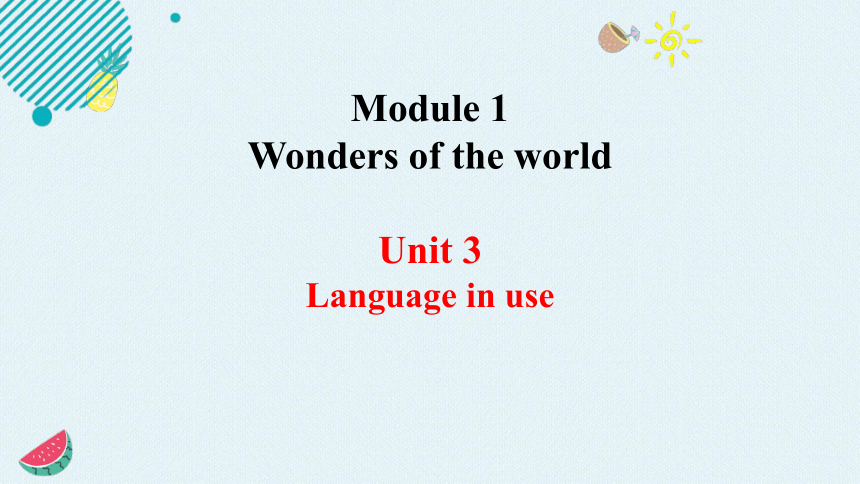 | |
| 格式 | pptx | ||
| 文件大小 | 3.2MB | ||
| 资源类型 | 教案 | ||
| 版本资源 | 外研版 | ||
| 科目 | 英语 | ||
| 更新时间 | 2024-11-08 08:36:37 | ||
图片预览

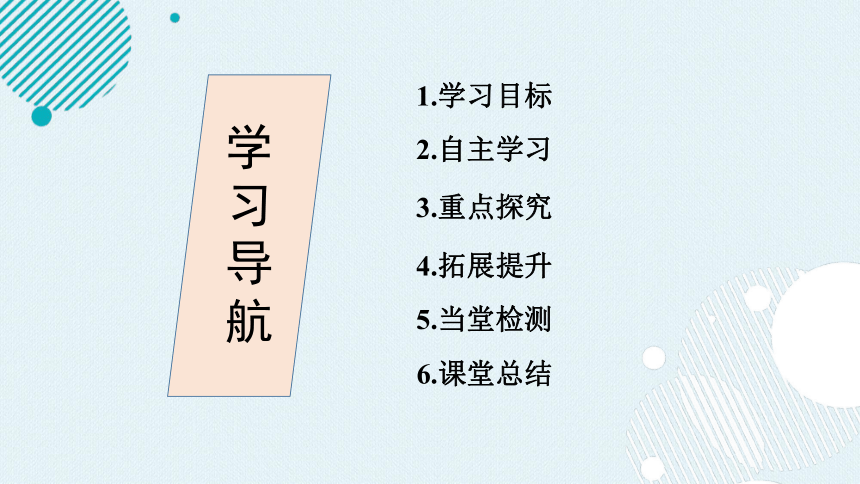


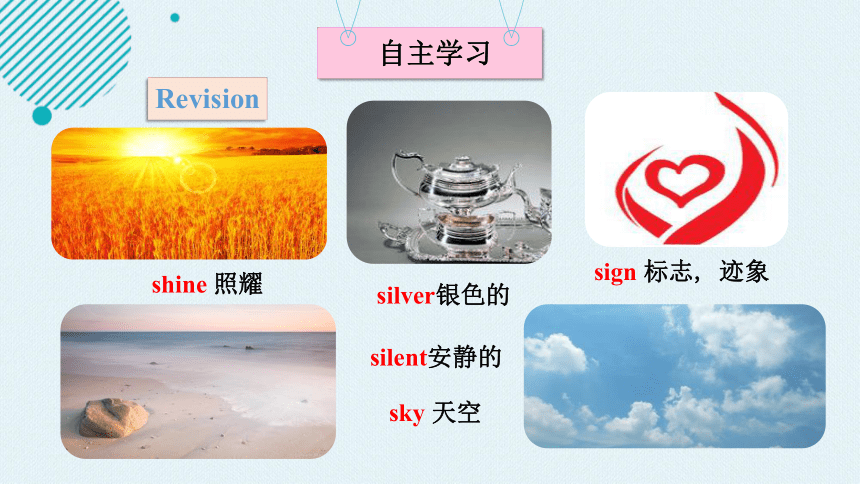
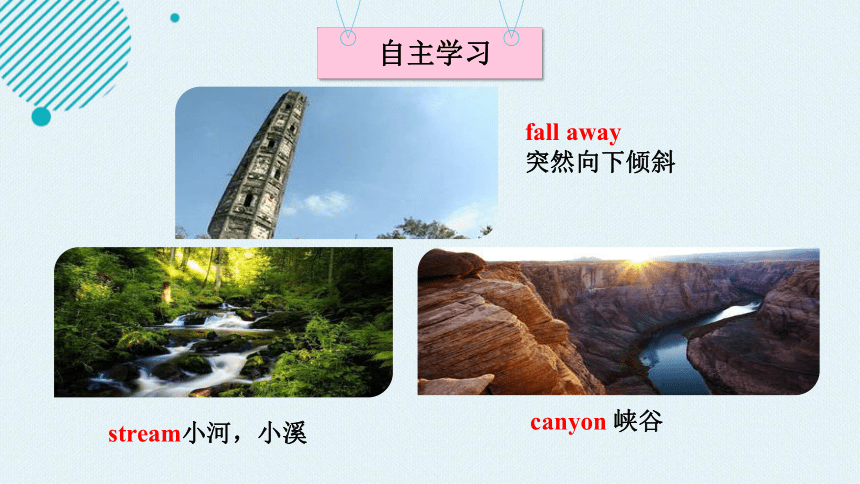



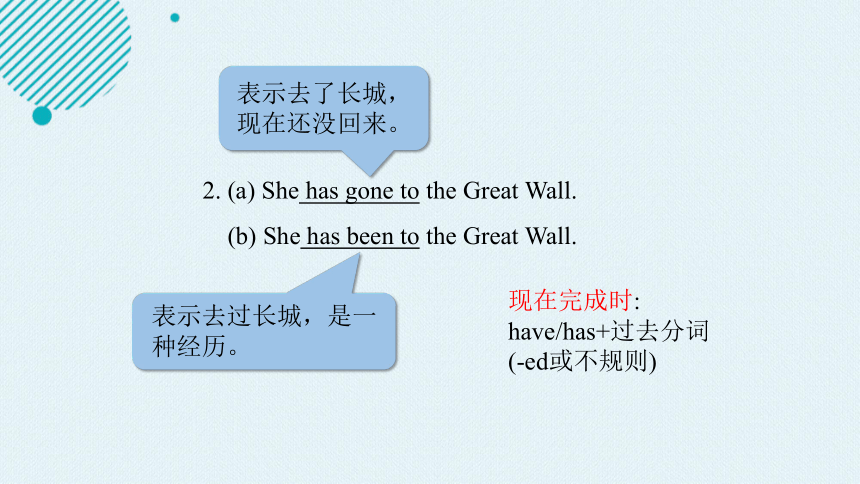
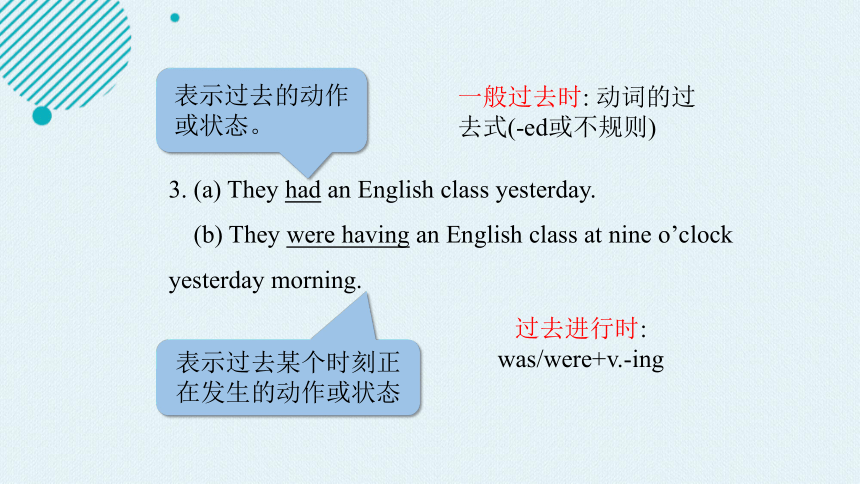

文档简介
(共33张PPT)
Module 1
Wonders of the world
Unit 3
Language in use
1.学习目标
3.重点探究
2.自主学习
学习导航
5.当堂检测
6.课堂总结
4.拓展提升
新课导入
Where is it
Have you ever visited it
How high is it
The Jin Mao Tower
When did you visit it
When will you visit it
1.能熟悉并能正确运用本模块的单词和短语
2.能够掌握一般现在时、一般过去时、现在进行时、过去进行时、一般将来时和现在完成时等六种基本时态的谓语构成及运用
3.能用英语谈论自己了解的世界奇观
学习目标
自主学习
Revision
shine 照耀
sign 标志, 迹象
silent安静的
silver银色的
sky 天空
自主学习
fall away
突然向下倾斜
stream小河,小溪
canyon 峡谷
重点探究
1. I ________ the Giant’s Causeway two years ago.
我两年前参观了巨人堤道。
2. It __________ electricity for millions of people in China.
它为中国数百万的人供电。
visited
produces
3. _______________ it, so I’m not sure I agree with you.
我没有见过巨人堤道,所以我不确定该不该同意你的看法。
4. I ______ to the east-the sky _____________ grey.
我朝东边看了看,天空变得灰蒙蒙的。
I’ve never seen
looked
was becoming
5. ______________ in five minutes.
你五分钟就能到那里。
6. Am I going the right way
我走得对吗?
You’ll get there
Language practice
1. a) I often play basketball.
b) I am playing basketball now.
2. a) She has gone to the Great Wall.
b) She has been to the Great Wall.
3. a) They had an English class yesterday.
b) They were having an English class at nine o’clock
yesterday morning.
4. a) He is doing an interview.
b) He has done an interview.
5. a) We are drawing a picture of Victoria Falls now.
b) We will draw a picture of Victoria Falls.
1. Explain the difference in meaning between Sentences (a) and (b).
1. (a) I often play basketball.
(b) I am playing basketball now.
表示经常性,习惯性的动作
表示说话时正在进行的动作或行为。
一般现在时: 谓语动词用原形或第三人称单数 (-s/es)
现在进行时: am/is/are+v.-ing
2. (a) She has gone to the Great Wall.
(b) She has been to the Great Wall.
现在完成时: have/has+过去分词(-ed或不规则)
表示去了长城,现在还没回来。
表示去过长城,是一种经历。
3. (a) They had an English class yesterday.
(b) They were having an English class at nine o’clock yesterday morning.
一般过去时: 动词的过去式(-ed或不规则)
过去进行时: was/were+v.-ing
表示过去的动作或状态。
表示过去某个时刻正在发生的动作或状态
4. (a) He is doing an interview.
(b) He has done an interview.
现在进行时: am/is/are+v.-ing
现在完成时: have/has+过去分词(-ed或不规则)
表示正在进行采访
表示已经完成采访
5. (a) We are drawing a picture of Victoria Falls now.
(b) We will draw a picture of Victoria Falls now.
一般将来时: be going to/will +动词原形
现在进行时: am/is/are+v.-ing
表示说话时正在进行的动作
表示动作还没发生
appear finish give rain talk visit walk
1. Listen! It _________ outside.
2. The great musician _____________ a concert in Guangzhou next month.
3. Last summer, my parents ______the Terracotta Army in Xi’an.
4. He _____ already __________ a new book about travel.
is raining
will give
visited
has finished
5. Thousands of people ______along the Great Wall every year.
6. A few minutes later, a stranger _________ at the end of the street.
7. The students ____________about the journey to the Grand Canyon when the teacher came into the classroom.
walk
will appear
were talking
2. Complete the sentences with the correct form of the words in the box.
The sun was going down when we (1) _______ (arrive) at the ground floor of the building. I (2) ____ (be) afraid of going to the top of tall buildings, so I was a little nervous when I (3) __________ (walk) into the lift. The lift (4) ________ (climb) faster and faster until we (5) ________ (reach) the 88th floor.It (6) _____ (be) high up there, but I was not afraid when I stood at the top.
arrived
was
walked
climbed
reached
The Jin Mao Tower in Shanghai, one of the tallest buildings in the world, (7) ___ (be) 420.5 meters high. It was built in 1999, and it (8) ____ (have) a fantastic view of Pudong District and the centre of Shanghai. I really like the tower and I am sure I (9) _________ (visit) it again.
is
has
will visit
was
3. Complete the passage with the correct form of the words in brackets.
A: Have you ever visited the Great Wall
B: Yes, I have. / No, I haven’t.
A: When did you visit it / When will you visit it
B: I visited it five years ago. / Maybe I’ll visit it next year.
4. Work in pairs. Talk about the wonders of the
world you have or have not visited.
Wonders of the world When did you visit it When will you visit it
The Great Wall
Now complete the table.
1. The Changjiang River is about 6,300 kilometres _________.
2. The Terracotta Army is a famous ___________ wonder in China.
long
ancient
ancient high long natural opinion wonder
3. For my homework I have to write an article about the _________ of the world.
4. Mount Qomolangma is the ________ mountain in the world.
5. In my ________, the Great Wall is the greatest man-made wonder in the world.
wonders
highest
opinion
5.Complete the sentences with the correct form of the words in the box. There is one extra word.
I’m really (1) ________________ my visit to the Louvre Museum in Paris. It’s the most visited museum in the world-every year, (2) __________ people visit it. The Louvre is in an old building, but to get inside you must (3) __________ a giant glass pyramid that is (4) _________ 20 metres tall. The entrance to the museum is (5) ______________ the pyramid. Some people do not like the glass pyramid. They say it looks too new and does not suit the older building. I do not (6) ____________ them. I think it looks great!
looking forward to
millions of
go through
more than
at the bottom of
agree with
agree with at the bottom of go through
looking forward to millions of more than
6. Complete the passage with the expressions in the box.
1
2
3
The Great Pyramid
at Giza
Mount Qomolangma
The Empire
State Building
7. Listen and number the pictures.
Mount Qomolangma The Empire State Building The Great
Pyramid at Giza
Location Between China and Nepal __________ In Egypt
Height ________metres _____metres About_______
metres now
Interesting facts First people to climb to the top: Sir Edmund Hillary and Tenzing Norgay ____ floors About
________
years old
8,844.43
New York
381
137
102
4,500
8. Listen again and complete the table.
A: Where is...
B: It’s...
A: How high is it
B: It’s... metres high.
9. Work in pairs. Think about three other wonders of the world and ask and answer questions about them.
Stonehenge is an ancient circle of stones in the south of England. It is about 5,000 years old. It was probably a place to bury dead people or a place to study the stars and the sky at night.
Stonehenge: a man-made wonder of the world
There are dozens of stones, and they are different in height. The stones came from about 200 kilometres away.Some of the stones are missing, but it is still one of the most wonderful sights of the world. It is a wonder also because of this question: How did ancient people move these huge stones without machines to help them No one knows the answer.
Around the w rld
●Decide on the wonder of the world for your poster.
●Find out as much information as you can in books
and on websites. Think about:
1. Why should people visit the wonder
2. What will people see there
3. How can people get there
4. How much does it cost to visit the wonder
5. When is the best time to visit the wonder
●Make a poster. Find some pictures showing the wonder.
10. Work in groups of four.
Make a poster about a wonder of the world.
11. Present your poster to the class.
拓展提升
Language points
一般现在时
意义:
1)经常发生或反复发生的动作;
eg. He always helps others. 他总是帮助别人。
2) 现存的情况或状态;
eg. My piano is quite new. 我的钢琴非常新。
3) 客观事实或普遍真理等。
eg. The earth moves around the sun. 地球围着太阳转。
注意:主语为第三人单数时,动词要变为第三人称单数形式。
一般过去时
意义:
1)表示过去某个时间发生的动作或情况。
eg.I worked in that factory last year.
去年我在那家工厂里工作。
2)表示过去习惯性动作。特别是由would/ used to do表达的句型,本身表示的就是过去时。
eg.He used to visit his mother once a week.
他以前总是每周看望一次他的母亲。
现在进行时
意义:
表示说话时或者现阶段、最近一段时间在进行的动作或行为。
eg. I am looking for my key.
我正在寻找我的钥匙。
注意:有些动词一般不可以用于进行时态
1)表示状态的动词,尤其是静态动词,如:be, have
2)表示认识、知觉和情感的动词,如:know, think, hear, find, see, like, want, wish, prefer等。
过去进行时
意义:
1)过去进行时表示过去某一时刻或过去某一阶段正在进行的动作。
eg. Mary was listening to light music 10 minutes ago.
10分钟前,玛丽正在听轻音乐。
2)如果when, while这样的时间状语引导词所引导的主从句之一是一般过去时,则另一个句子常用过去进行时。
eg. I was washing my hair when you knocked at the front door. 你敲前门时我正在洗头发。
一般将来时
意义:
1. 计划或打算要做的动作;
2. 将要发生的动作或存在的状态。
eg.
We shall send her a hand-made glass craft as her birthday gift.我们将送给她一个玻璃的手工制品,作为给她的生日礼物。
My mother is coming to visit me next week and is staying here until May.
我妈妈下周将来看我,并会呆到5月。
现在完成时
意义:
现在完成时表示某一动作对现在造成的影响或结果,也可表示过去发生的事一直持续到现在。
eg. John has broken his left leg.
约翰摔断了左腿。
注意:
have/has been to 意为“曾经去过某地”,表示一经历;
have/has gone to 意为“到某地去了”。
eg. Mr Black has been to Beijing.
布莱克先生曾经去过北京。
一般现在时
2. 一般过去时
3. 一般将来
4. 现在进行时
5. 过去进行时
6. 现在完成时
动词原形或动词+s/es
动词过去式
will +V./be going to + V.
am/is /are +V.ing
was/ were + V.ing
have /has +P.P
结构总结
当堂检测
1. She often _____(read) English in the evening.
2. There ________( be) a film tomorrow evening.
3. Look! The twins ____________( help) their mother do the housework.
4. They ______( take) photos near the river an hour ago.
5. We ___________( learn) English for three years already. And we can speak a little English now.
6. I first met Tom 10 years ago. He __________ (work) in a radio factory at that time.
reads
will be
are helping
have learnt
took
was working
一、用括号内单词的适当形式填空
课堂总结
Module 1
Unit 3
理解各时态的意义和用法: 一般现在时
一般过去时
现在进行时
过去进行时
一般将来时
现在完成时
重点单词和短语:
have gone to,have been to,do an interview,at the end of,be afraid of,agree with,at the bottom of,go through,look forward to,more than,millions of,in height,because of
Module 1
Wonders of the world
Unit 3
Language in use
1.学习目标
3.重点探究
2.自主学习
学习导航
5.当堂检测
6.课堂总结
4.拓展提升
新课导入
Where is it
Have you ever visited it
How high is it
The Jin Mao Tower
When did you visit it
When will you visit it
1.能熟悉并能正确运用本模块的单词和短语
2.能够掌握一般现在时、一般过去时、现在进行时、过去进行时、一般将来时和现在完成时等六种基本时态的谓语构成及运用
3.能用英语谈论自己了解的世界奇观
学习目标
自主学习
Revision
shine 照耀
sign 标志, 迹象
silent安静的
silver银色的
sky 天空
自主学习
fall away
突然向下倾斜
stream小河,小溪
canyon 峡谷
重点探究
1. I ________ the Giant’s Causeway two years ago.
我两年前参观了巨人堤道。
2. It __________ electricity for millions of people in China.
它为中国数百万的人供电。
visited
produces
3. _______________ it, so I’m not sure I agree with you.
我没有见过巨人堤道,所以我不确定该不该同意你的看法。
4. I ______ to the east-the sky _____________ grey.
我朝东边看了看,天空变得灰蒙蒙的。
I’ve never seen
looked
was becoming
5. ______________ in five minutes.
你五分钟就能到那里。
6. Am I going the right way
我走得对吗?
You’ll get there
Language practice
1. a) I often play basketball.
b) I am playing basketball now.
2. a) She has gone to the Great Wall.
b) She has been to the Great Wall.
3. a) They had an English class yesterday.
b) They were having an English class at nine o’clock
yesterday morning.
4. a) He is doing an interview.
b) He has done an interview.
5. a) We are drawing a picture of Victoria Falls now.
b) We will draw a picture of Victoria Falls.
1. Explain the difference in meaning between Sentences (a) and (b).
1. (a) I often play basketball.
(b) I am playing basketball now.
表示经常性,习惯性的动作
表示说话时正在进行的动作或行为。
一般现在时: 谓语动词用原形或第三人称单数 (-s/es)
现在进行时: am/is/are+v.-ing
2. (a) She has gone to the Great Wall.
(b) She has been to the Great Wall.
现在完成时: have/has+过去分词(-ed或不规则)
表示去了长城,现在还没回来。
表示去过长城,是一种经历。
3. (a) They had an English class yesterday.
(b) They were having an English class at nine o’clock yesterday morning.
一般过去时: 动词的过去式(-ed或不规则)
过去进行时: was/were+v.-ing
表示过去的动作或状态。
表示过去某个时刻正在发生的动作或状态
4. (a) He is doing an interview.
(b) He has done an interview.
现在进行时: am/is/are+v.-ing
现在完成时: have/has+过去分词(-ed或不规则)
表示正在进行采访
表示已经完成采访
5. (a) We are drawing a picture of Victoria Falls now.
(b) We will draw a picture of Victoria Falls now.
一般将来时: be going to/will +动词原形
现在进行时: am/is/are+v.-ing
表示说话时正在进行的动作
表示动作还没发生
appear finish give rain talk visit walk
1. Listen! It _________ outside.
2. The great musician _____________ a concert in Guangzhou next month.
3. Last summer, my parents ______the Terracotta Army in Xi’an.
4. He _____ already __________ a new book about travel.
is raining
will give
visited
has finished
5. Thousands of people ______along the Great Wall every year.
6. A few minutes later, a stranger _________ at the end of the street.
7. The students ____________about the journey to the Grand Canyon when the teacher came into the classroom.
walk
will appear
were talking
2. Complete the sentences with the correct form of the words in the box.
The sun was going down when we (1) _______ (arrive) at the ground floor of the building. I (2) ____ (be) afraid of going to the top of tall buildings, so I was a little nervous when I (3) __________ (walk) into the lift. The lift (4) ________ (climb) faster and faster until we (5) ________ (reach) the 88th floor.It (6) _____ (be) high up there, but I was not afraid when I stood at the top.
arrived
was
walked
climbed
reached
The Jin Mao Tower in Shanghai, one of the tallest buildings in the world, (7) ___ (be) 420.5 meters high. It was built in 1999, and it (8) ____ (have) a fantastic view of Pudong District and the centre of Shanghai. I really like the tower and I am sure I (9) _________ (visit) it again.
is
has
will visit
was
3. Complete the passage with the correct form of the words in brackets.
A: Have you ever visited the Great Wall
B: Yes, I have. / No, I haven’t.
A: When did you visit it / When will you visit it
B: I visited it five years ago. / Maybe I’ll visit it next year.
4. Work in pairs. Talk about the wonders of the
world you have or have not visited.
Wonders of the world When did you visit it When will you visit it
The Great Wall
Now complete the table.
1. The Changjiang River is about 6,300 kilometres _________.
2. The Terracotta Army is a famous ___________ wonder in China.
long
ancient
ancient high long natural opinion wonder
3. For my homework I have to write an article about the _________ of the world.
4. Mount Qomolangma is the ________ mountain in the world.
5. In my ________, the Great Wall is the greatest man-made wonder in the world.
wonders
highest
opinion
5.Complete the sentences with the correct form of the words in the box. There is one extra word.
I’m really (1) ________________ my visit to the Louvre Museum in Paris. It’s the most visited museum in the world-every year, (2) __________ people visit it. The Louvre is in an old building, but to get inside you must (3) __________ a giant glass pyramid that is (4) _________ 20 metres tall. The entrance to the museum is (5) ______________ the pyramid. Some people do not like the glass pyramid. They say it looks too new and does not suit the older building. I do not (6) ____________ them. I think it looks great!
looking forward to
millions of
go through
more than
at the bottom of
agree with
agree with at the bottom of go through
looking forward to millions of more than
6. Complete the passage with the expressions in the box.
1
2
3
The Great Pyramid
at Giza
Mount Qomolangma
The Empire
State Building
7. Listen and number the pictures.
Mount Qomolangma The Empire State Building The Great
Pyramid at Giza
Location Between China and Nepal __________ In Egypt
Height ________metres _____metres About_______
metres now
Interesting facts First people to climb to the top: Sir Edmund Hillary and Tenzing Norgay ____ floors About
________
years old
8,844.43
New York
381
137
102
4,500
8. Listen again and complete the table.
A: Where is...
B: It’s...
A: How high is it
B: It’s... metres high.
9. Work in pairs. Think about three other wonders of the world and ask and answer questions about them.
Stonehenge is an ancient circle of stones in the south of England. It is about 5,000 years old. It was probably a place to bury dead people or a place to study the stars and the sky at night.
Stonehenge: a man-made wonder of the world
There are dozens of stones, and they are different in height. The stones came from about 200 kilometres away.Some of the stones are missing, but it is still one of the most wonderful sights of the world. It is a wonder also because of this question: How did ancient people move these huge stones without machines to help them No one knows the answer.
Around the w rld
●Decide on the wonder of the world for your poster.
●Find out as much information as you can in books
and on websites. Think about:
1. Why should people visit the wonder
2. What will people see there
3. How can people get there
4. How much does it cost to visit the wonder
5. When is the best time to visit the wonder
●Make a poster. Find some pictures showing the wonder.
10. Work in groups of four.
Make a poster about a wonder of the world.
11. Present your poster to the class.
拓展提升
Language points
一般现在时
意义:
1)经常发生或反复发生的动作;
eg. He always helps others. 他总是帮助别人。
2) 现存的情况或状态;
eg. My piano is quite new. 我的钢琴非常新。
3) 客观事实或普遍真理等。
eg. The earth moves around the sun. 地球围着太阳转。
注意:主语为第三人单数时,动词要变为第三人称单数形式。
一般过去时
意义:
1)表示过去某个时间发生的动作或情况。
eg.I worked in that factory last year.
去年我在那家工厂里工作。
2)表示过去习惯性动作。特别是由would/ used to do表达的句型,本身表示的就是过去时。
eg.He used to visit his mother once a week.
他以前总是每周看望一次他的母亲。
现在进行时
意义:
表示说话时或者现阶段、最近一段时间在进行的动作或行为。
eg. I am looking for my key.
我正在寻找我的钥匙。
注意:有些动词一般不可以用于进行时态
1)表示状态的动词,尤其是静态动词,如:be, have
2)表示认识、知觉和情感的动词,如:know, think, hear, find, see, like, want, wish, prefer等。
过去进行时
意义:
1)过去进行时表示过去某一时刻或过去某一阶段正在进行的动作。
eg. Mary was listening to light music 10 minutes ago.
10分钟前,玛丽正在听轻音乐。
2)如果when, while这样的时间状语引导词所引导的主从句之一是一般过去时,则另一个句子常用过去进行时。
eg. I was washing my hair when you knocked at the front door. 你敲前门时我正在洗头发。
一般将来时
意义:
1. 计划或打算要做的动作;
2. 将要发生的动作或存在的状态。
eg.
We shall send her a hand-made glass craft as her birthday gift.我们将送给她一个玻璃的手工制品,作为给她的生日礼物。
My mother is coming to visit me next week and is staying here until May.
我妈妈下周将来看我,并会呆到5月。
现在完成时
意义:
现在完成时表示某一动作对现在造成的影响或结果,也可表示过去发生的事一直持续到现在。
eg. John has broken his left leg.
约翰摔断了左腿。
注意:
have/has been to 意为“曾经去过某地”,表示一经历;
have/has gone to 意为“到某地去了”。
eg. Mr Black has been to Beijing.
布莱克先生曾经去过北京。
一般现在时
2. 一般过去时
3. 一般将来
4. 现在进行时
5. 过去进行时
6. 现在完成时
动词原形或动词+s/es
动词过去式
will +V./be going to + V.
am/is /are +V.ing
was/ were + V.ing
have /has +P.P
结构总结
当堂检测
1. She often _____(read) English in the evening.
2. There ________( be) a film tomorrow evening.
3. Look! The twins ____________( help) their mother do the housework.
4. They ______( take) photos near the river an hour ago.
5. We ___________( learn) English for three years already. And we can speak a little English now.
6. I first met Tom 10 years ago. He __________ (work) in a radio factory at that time.
reads
will be
are helping
have learnt
took
was working
一、用括号内单词的适当形式填空
课堂总结
Module 1
Unit 3
理解各时态的意义和用法: 一般现在时
一般过去时
现在进行时
过去进行时
一般将来时
现在完成时
重点单词和短语:
have gone to,have been to,do an interview,at the end of,be afraid of,agree with,at the bottom of,go through,look forward to,more than,millions of,in height,because of
同课章节目录
- Module 1 Wonders of the world
- Unit 1 It's more than 2,000 years old.
- Unit 2 The Grand Canyon was not just big.
- Unit 3 Language in use
- Module 2 Public holidays
- Unit 1 My family always go somewhere interesting a
- Unit 2 We have celebrated the festival since the f
- Unit 3 Language in use
- Module 3 Heroes
- Unit 1 She trained hard,so she became a great play
- Unit 2There were few doctors, so he had to work ve
- Unit 3 Language in use
- Module 4 Home alone
- Unit 1 I can look after myself, although it won’t
- Unit 2 I became so bored with their orders that I
- Unit 3 Language in use
- Module 5 Museums
- Unit 1 Don't cross that rope!
- Unit 2 If you ever go to London, make sure you vis
- Unit 3 Language in use
- Module 6 Problems
- Unit 1 If I start after dinner, I'll finish it be
- Unit 2 If you tell him the truth now, you will sho
- Unit 3 Language in use
- Revision Module A
- Module 7 Great books
- Unit 1 We're still influenced by Confucius's idea
- Unit 2 It is still read and loved.
- Unit 3 Language in use
- Module 8 Sports life
- Unit 1 Daming wasn't chosen for the team last time
- Unit 2 He was invited to competitions around the w
- Unit 3 Language in use
- Module 9 Great inventions
- Unit 1 Will computers be used more than books in t
- Unit 2 Will books be replaced by the Internet?
- Unit 3 Language in use
- Module 10 Australia
- Unit 1 I have some photos that I took in Australia
- Unit 2 The game that they like most is Australian
- Unit 3 Language in use
- Module 11 Photos
- Unit 1 He's the boy who won the photo competition
- Unit 2 The photo which we liked best was taken by
- Unit 3 Language in use
- Module 12 Save our world
- Unit 1 If everyone starts to do something, the wor
- Unit 2 Repeat these three words daily: reduce, reu
- Unit 3 Language in use
- Revision Module B
